NCERT Solutions Class 9 Maths Chapter 6 Lines ans Angles – In this topic we learn basic Geometry primarily focusing on the properties of the angles formed i) when two lines intersect each other and ii) when a line intersects two or more parallel lines at distinct points. This chapter falls under the Unit – Geometry and is included for the CBSE Syllabus of Class 9 Maths. Check previous chapter solutions – NCERT Solutions for Class 9 Maths Chapter 5 Introduction Euclids Geometry
ALSO CHECK – NCERT Solutions for Class 10 Maths
NCERT Solutions Class 9 Maths Chapter 6 Lines ans Angles is prepared by our best subject experts teachers group thats help students to understand all the topics easily. These Solutions of NCERT Maths help the students in solving the problems efficiently for the upcoming exams. With the help of these NCERT Solutions for Class 9 Maths, students can understand the complex topics of class 9 Maths.
NCERT Solutions for Class 9 Maths Chapter 6 Lines and Angles Exercise 6.1
Question 1
In figure, lines AB and CD intersect at 0. If ∠AOC + ∠BOE = 70° and ∠BOD = 40°, find ∠BOE and reflex ∠COE.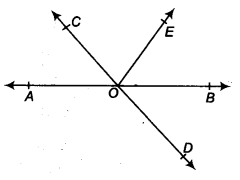
Solution:
Since AB is a straight line,
∴ ∠AOC + ∠COE + ∠EOB = 180°
or (∠AOC + ∠BOE) + ∠COE = 180° or 70° + ∠COE = 180° [ ∵∠AOC + ∠BOE = 70° (Given)]
or ∠COE = 180° – 70° = 110°
∴ Reflex ∠COE = 360° – 110° = 250°
Also, AB and CD intersect at O.
∴∠COA = ∠BOD [Vertically opposite angles]
But ∠BOD = 40° [Given]
∴ ∠COA = 40°
Also, ∠AOC + ∠BOE = 70°
∴ 40° + ∠BOE = 70° or ∠BOE = 70° -40° = 30°
Thus, ∠BOE = 30° and reflex ∠COE = 250°.
Question 2.
In figure, lines XY and MN intersect at 0. If ∠POY = 90° , and a : b = 2 : 3. find c.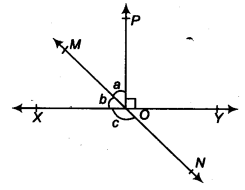
Solution:
Since XOY is a straight line.
∴ b+a+∠POY= 180°
But ∠POY = 90° [Given]
∴ b + a = 180° – 90° = 90° …(i)
Also a : b = 2 : 3 ⇒ b = 3𝑎2 …(ii)
Now from (i) and (ii), we get
3𝑎2 + A = 90°
⇒ 5𝑎2 = 90°
⇒ a = 90∘5×2=36∘ = 36°
From (ii), we get
b = 32 x 36° = 54°
Since XY and MN interstect at O,
∴ c = [a + ∠POY] [Vertically opposite angles]
or c = 36° + 90° = 126°
Thus, the required measure of c = 126°.
Question 3.
In figure, ∠PQR = ∠PRQ, then prove that ∠PQS = ∠PRT.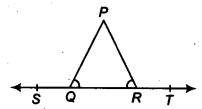
Solution:
ST is a straight line.
∴ ∠PQR + ∠PQS = 180° …(1) [Linear pair]
Similarly, ∠PRT + ∠PRQ = 180° …(2) [Linear Pair]
From (1) and (2), we have
∠PQS + ∠PQR = ∠PRT + ∠PRQ
But ∠PQR = ∠PRQ [Given]
∴ ∠PQS = ∠PRT
Question 4.
In figure, if x + y = w + ⇒, then prove that AOB is a line.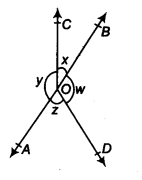
Solution:
Sum of all the angles at a point = 360°
∴ x + y + ⇒ + w = 360° or, (x + y) + (⇒ + w) = 360°
But (x + y) = (⇒ + w) [Given]
∴ (x + y) + (x + y) = 360° or,
2(x + y) = 360°
or, (x + y) = 360∘2 = 180°
∴ AOB is a straight line.
Question 5.
In figure, POQ is a line. Ray OR is perpendicular to line PQ. OS is another ray lying between rays OP and OR. Prove that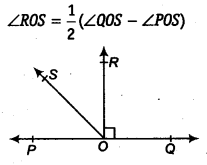
Solution:
rara POQ is a straight line. [Given]
∴ ∠POS + ∠ROS + ∠ROQ = 180°
But OR ⊥ PQ
∴ ∠ROQ = 90°
⇒ ∠POS + ∠ROS + 90° = 180°
⇒ ∠POS + ∠ROS = 90°
⇒ ∠ROS = 90° – ∠POS … (1)
Now, we have ∠ROS + ∠ROQ = ∠QOS
⇒ ∠ROS + 90° = ∠QOS
⇒ ∠ROS = ∠QOS – 90° ……(2)
Adding (1) and (2), we have
2 ∠ROS = (∠QOS – ∠POS)
∴ ∠ROS = 12(∠𝑄𝑂𝑆−∠𝑃𝑂𝑆)
Question 6.
It is given that ∠XYZ = 64° and XY is produced to point P. Draw a figure from the given information. If ray YQ bisects ∠ZYP, find ∠XYQ and reflex ∠QYP.
Solution:
XYP is a straight line.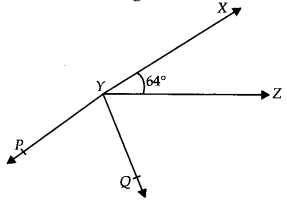
∴ ∠XYZ + ∠ZYQ + ∠QYP = 180°
⇒ 64° + ∠ZYQ + ∠QYP = 180°
[∵ ∠XYZ = 64° (given)]
⇒ 64° + 2∠QYP = 180°
[YQ bisects ∠ZYP so, ∠QYP = ∠ZYQ]
⇒ 2∠QYP = 180° – 64° = 116°
⇒ ∠QYP = 116∘2 = 58°
∴ Reflex ∠QYP = 360° – 58° = 302°
Since ∠XYQ = ∠XYZ + ∠ZYQ
⇒ ∠XYQ = 64° + ∠QYP [∵∠XYZ = 64°(Given) and ∠ZYQ = ∠QYP]
⇒ ∠XYQ = 64° + 58° = 122° [∠QYP = 58°]
Thus, ∠XYQ = 122° and reflex ∠QYP = 302°.
NCERT Solutions for Class 9 Maths Chapter 6 Lines and Angles Exercise 6.2
Ex 6.2 Class 9 Maths Question 1.
In figure, find the values of x and y and then show that AB || CD.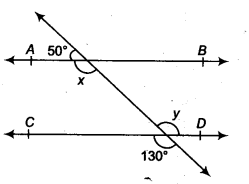
Solution:
In the figure, we have CD and PQ intersect at F.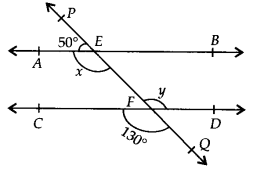
∴ y = 130° …(1)
[Vertically opposite angles]
Again, PQ is a straight line and EA stands on it.
∠AEP + ∠AEQ = 180° [Linear pair]
or 50° + x = 180°
⇒ x = 180° – 50° = 130° …(2)
From (1) and (2), x = y
As they are pair of alternate interior angles.
∴ AB || CD
Question 2.
In figure, if AB || CD, CD || EF and y : z = 3 : 7, find x.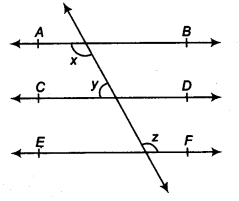
Solution:
AB || CD, and CD || EF [Given]
∴ AB || EF
∴ x = z [Alternate interior angles] ….(1)
Again, AB || CD
⇒ x + y = 180° [Co-interior angles]
⇒ z + y = 180° … (2) [By (1)]
But y : z = 3 : 7
z = 7/3 y = 7/3(180°- z) [By (2)]
⇒ 10z = 7 x 180°
⇒ z = 7 x 180° /10 = 126°
From (1) and (3), we have
x = 126°.
Question 3.
In figure, if AB || CD, EF ⊥ CD and ∠GED = 126°, find ∠AGE, ∠GEF and ∠FGE.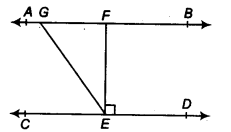
Solution:
AB || CD and GE is a transversal.
∴ ∠AGE = ∠GED [Alternate interior angles]
But ∠GED = 126° [Given]
∴∠AGE = 126°
Also, ∠GEF + ∠FED = ∠GED
or ∠GEF + 90° = 126° [∵ EF ⊥ CD (given)]
x = z [Alternate interior angles]… (1) Again, AB || CD
⇒ x + y = 180° [Co-interior angles]
∠GEF = 126° -90° = 36°
Now, AB || CD and GE is a transversal.
∴ ∠FGE + ∠GED = 180° [Co-interior angles]
or ∠FGE + 126° = 180°
or ∠FGE = 180° – 126° = 54°
Thus, ∠AGE = 126°, ∠GEF=36° and ∠FGE = 54°.
Question 4.
In figure, if PQ || ST, ∠ PQR = 110° and ∠ RST = 130°, find ∠QRS.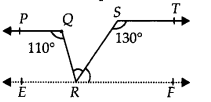
Solution:
Draw a line EF parallel to ST through R.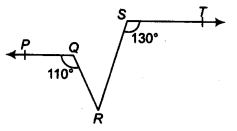
Since PQ || ST [Given]
and EF || ST [Construction]
∴ PQ || EF and QR is a transversal
⇒ ∠PQR = ∠QRF [Alternate interior angles] But ∠PQR = 110° [Given]
∴∠QRF = ∠QRS + ∠SRF = 110° …(1)
Again ST || EF and RS is a transversal
∴ ∠RST + ∠SRF = 180° [Co-interior angles] or 130° + ∠SRF = 180°
⇒ ∠SRF = 180° – 130° = 50°
Now, from (1), we have ∠QRS + 50° = 110°
⇒ ∠QRS = 110° – 50° = 60°
Thus, ∠QRS = 60°.
Question 5.
In figure, if AB || CD, ∠APQ = 50° and ∠PRD = 127°, find x and y.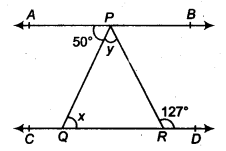
Solution:
We have AB || CD and PQ is a transversal.
∴ ∠APQ = ∠PQR
[Alternate interior angles]
⇒ 50° = x [ ∵ ∠APQ = 50° (given)]
Again, AB || CD and PR is a transversal.
∴ ∠APR = ∠PRD [Alternate interior angles]
⇒ ∠APR = 127° [ ∵ ∠PRD = 127° (given)]
⇒ ∠APQ + ∠QPR = 127°
⇒ 50° + y = 127° [ ∵ ∠APQ = 50° (given)]
⇒ y = 127°- 50° = 77°
Thus, x = 50° and y = 77°.
Question 6.
In figure, PQ and RS are two mirrors placed parallel to each other. An incident ray AB strikes the mirror PQ at B, the reflected ray moves along the path BC and strikes the mirror RS at C and again reflects back along CD. Prove that AB || CD.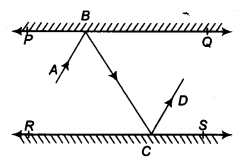
Solution:
Draw ray BL ⊥PQ and CM ⊥ RS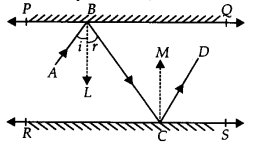
∵ PQ || RS ⇒ BL || CM
[∵ BL || PQ and CM || RS]
Now, BL || CM and BC is a transversal.
∴ ∠LBC = ∠MCB …(1) [Alternate interior angles]
Since, angle of incidence = Angle of reflection
∠ABL = ∠LBC and ∠MCB = ∠MCD
⇒ ∠ABL = ∠MCD …(2) [By (1)]
Adding (1) and (2), we get
∠LBC + ∠ABL = ∠MCB + ∠MCD
⇒ ∠ABC = ∠BCD
i. e., a pair of alternate interior angles are equal.
∴ AB || CD.
NCERT Solutions for Class 9 Maths Chapter 6 Lines and Angles Exercise 6.3
Question 1.
In figure, sides QP and RQ of ∆PQR are produced to points S and T, respectively. If ∠SPR = 135° and ∠PQT = 110°, find ∠PRQ.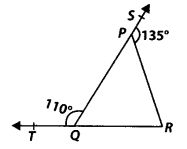
Solution:
We have, ∠TQP + ∠PQR = 180°
[Linear pair]
⇒ 110° + ∠PQR = 180°
⇒ ∠PQR = 180° – 110° = 70°
Since, the side QP of ∆PQR is produced to S.
⇒ ∠PQR + ∠PRQ = 135°
[Exterior angle property of a triangle]
⇒ 70° + ∠PRQ = 135° [∠PQR = 70°]
⇒ ∠PRQ = 135° – 70° ⇒ ∠PRQ = 65°
Question 2.
In figure, ∠X = 62°, ∠XYZ = 54°, if YO and ZO are the bisectors of ∠XYZ and ∠XZY respectively of ∆XYZ, find ∠OZY and ∠YOZ.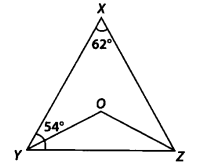
Solution:
In ∆XYZ, we have ∠XYZ + ∠YZX + ∠ZXY = 180°
[Angle sum property of a triangle]
But ∠XYZ = 54° and ∠ZXY = 62°
∴ 54° + ∠YZX + 62° = 180°
⇒ ∠YZX = 180° – 54° – 62° = 64°
YO and ZO are the bisectors of ∠XYZ and ∠XZY respectively.
∴ ∠OYZ = 1/2∠𝑋𝑌𝑍 = 1/2(54°) = 27°
and ∠OZY = 1/2∠𝑌𝑍𝑋 = 1/2(64°) = 32°
Now, in ∆OYZ, we have
∠YOZ + ∠OYZ + ∠OZY = 180°
[Angle sum property of a triangle]
⇒ ∠YOZ + 27° + 32° = 180°
⇒ ∠YOZ = 180° -27° – 32° = 121°
Thus, ∠OZY = 32° and ∠YOZ = 121°
Question 3.
In figure, if AB || DE, ∠BAC = 35° and ∠CDE = 539 , find ∠DCE.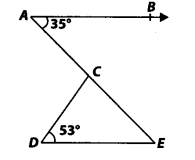
Solution:
AB || DE and AE is a transversal.
So, ∠BAC = ∠AED
[Alternate interior angles]
and ∠BAC = 35° [Given]
∴ ∠AED = 35°
Now, in ∆CDE, we have ∠CDE + ∠DEC + ∠DCE = 180°
{Angle sum property of a triangle]
∴ 53° + 35° + ∠DCE =180°
[∵ ∠DEC = ∠AED = 35° and∠CDE = 53° (Given)]
⇒ ∠DCE = 180° – 53° – 35° = 92°
Thus, ∠DCE = 92°
Question 4.
In figure, if lines PQ and RS intersect at point T, such that ∠ PRT = 40°, ∠ RPT = 95° and ∠TSQ = 75°, find ∠ SQT.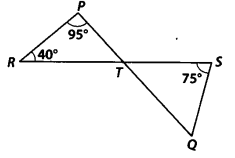
Solution:
In ∆PRT, we have ∠P + ∠R + ∠PTR = 180°
[Angle sum property of a triangle]
⇒ 95° + 40° + ∠PTR =180°
[ ∵ ∠P = 95°, ∠R = 40° (given)]
⇒ ∠PTR = 180° – 95° – 40° = 45°
But PQ and RS intersect at T.
∴ ∠PTR = ∠QTS
[Vertically opposite angles]
∴ ∠QTS = 45° [ ∵ ∠PTR = 45°]
Now, in ∆ TQS, we have ∠TSQ + ∠STQ + ∠SQT = 180°
[Angle sum property of a triangle]
∴ 75° + 45° + ∠SQT = 180° [ ∵ ∠TSQ = 75° and ∠STQ = 45°]
⇒ ∠SQT = 180° – 75° – 45° = 60°
Thus, ∠SQT = 60°
Question 5.
In figure, if PQ ⊥ PS, PQ||SR, ∠SQR = 2S° and ∠QRT = 65°, then find the values of x and y.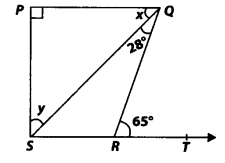
Solution:
In ∆ QRS, the side SR is produced to T.
∴ ∠QRT = ∠RQS + ∠RSQ
[Exterior angle property of a triangle]
But ∠RQS = 28° and ∠QRT = 65°
So, 28° + ∠RSQ = 65°
⇒ ∠RSQ = 65° – 28° = 37°
Since, PQ || SR and QS is a transversal.
∴ ∠PQS = ∠RSQ = 37°
[Alternate interior angles]
⇒ x = 37°
Again, PQ ⊥ PS ⇒ AP = 90°
Now, in ∆PQS,
we have ∠P + ∠PQS + ∠PSQ = 180°
[Angle sum property of a triangle]
⇒ 90° + 37° + y = 180°
⇒ y = 180° – 90° – 37° = 53°
Thus, x = 37° and y = 53°
Question 6.
In figure, the side QR of ∆PQR is produced to a point S. If the bisectors of ∠PQR and ∠PRS meet at point T, then prove that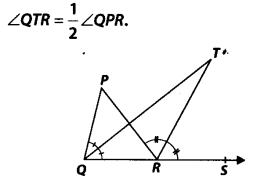
Solution:
In ∆PQR, side QR is produced to S, so by exterior angle property,
∠PRS = ∠P + ∠PQR
⇒ 1/2∠PRS = 1/2∠P + 1/2∠PQR
⇒ ∠TRS = 1/2∠P + ∠TQR …(1)
[∵ QT and RT are bisectors of ∠PQR and ∠PRS respectively.]
Now, in ∆QRT, we have
∠TRS = ∠TQR + ∠T …(2)
[Exterior angle property of a triangle]
From (1) and (2),
we have ∠TQR + 1/2∠P = ∠TQR + ∠T
⇒ 1/2∠P = ∠T
⇒ 1/2∠QPR = ∠QTR or ∠QTR = 1/2∠QPR
